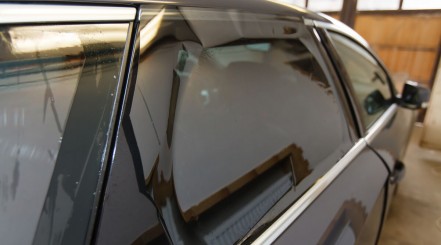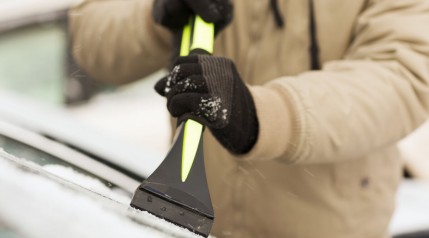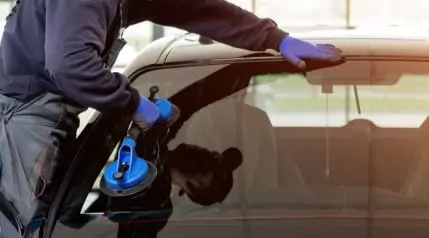
Whether you live in a warm climate or cold weather, you’re never immune to foggy car windows.
Let’s say it’s a brisk, sunny, winter morning. You leave the house, coffee-to-go in one hand, and you’re all ready for work. You get in, turn on the engine, and then realize that you can’t see through your foggy windshield.
Driving with poor visibility can be dangerous, so for your own safety, that of your passengers, and that of anyone else who happens to be around you on the road at the time, you’ll have to waste time defogging your windows before you can go anywhere.
This article will reveal the reasons why your car windows fog up, show you what to do when this happens, and also offers some valuable tips that will help prevent this from happening in the future.
Ready to learn how to stop car windows from fogging up? Let’s do it!
Contents (Jump to Topic)
Key Takeaways
- The Cause – Window fogging or condensation occurs as a result of the humidity inside your vehicle or a large difference between the interior temperature and ambient temperature.
- Inside or Out? – The cure for foggy windows varies depending on whether the condensation is forming inside or out (see below for details!)
- Prevention Strategies – To prevent window fogging, remove any damp items from your vehicle, air it out every so often, clean your auto glass regularly, and have any leaks taken care of by a mechanic.
What Should I Do When Car Windows Fog?
We’ll first discuss condensation on the outside of the car glass. This happens when the outside temperature is warmer than inside. For example, this will happen on a hot summer day when you’re driving with your AC on.
What you need to do to stop condensation is balance the outside and inside temperatures. This means that you’ll need to warm up the inside of the vehicle so that its glass will be as warm as the air outside.
Condensation on the Outside of the Car
Let’s look at the steps needed to get rid of window fogging on the outside:
- Turn on your windshield wipers. This will help you get rid of the condensation that has already formed on the outside of the glass.
- Warm up the inside. This will help prevent more condensation from forming. Turn on your AC and set it to a temperature that matches the outside one. Always remember that you want the inside of the car to be comfortable, not too hot.
- Turn off the recirculation button. If there’s a lot of excess moisture in the car, bringing fresh air inside will help to get rid of that moisture.
- Open the windows. By opening them, the fresh air coming from the outside will create a balance with the air inside.
Condensation on the Inside of the Car
Now, let’s discuss what you’ll need to do when you have condensation on the inside of your car’s windows. This will happen, for example, on a winter day when you enter your car and turn the engine on.
When you find yourself in such a situation, take the following steps:
- Turn on the defrost button. You may have to wait for the engine to be warm enough to see any results. The defrost button blows warm air on the glass, and the heating system works to trap water molecules.
- Turn off the recirculate setting. If you don’t do this step, the moist air inside the car will keep recirculating. To fight condensation, it’s very important to have fresh air from the outside coming in.
- Crack open the windows. Again, this will help balance out the inside and outside air temperatures, helping to defog. Leaving them cracked for a few minutes will be enough to get the job done.
Just in case your defroster setting button doesn’t work, this doesn’t mean you’re now helpless. If your defrost button doesn’t work, follow these steps instead:
- Turn on the heat. You want it to be at the highest setting possible, as warm or hot air will help capture moisture. You may have to wait a few minutes to make sure the engine is warm enough. If not, even if you turn on the heat at maximum power, the air will not be hot.
- Turn on your AC. The moisture will be extracted from the air as the air conditioning cools it down.
- Turn off recirculation. This will bring cooler air, which is not as moist, into the car from the outside.
- Crack open the windows. Whether you use the defrost button or not to defrost your windshield, letting fresh, dry air make its way into your car will balance the temperature difference.
How to Stop Car Windows From Fogging Up In The Future: Prevention Strategies
The steps we shared so far are useful to solve condensation issues whenever they happen. However, an important question remains: what can you do to prevent your car windows from fogging up again in the future?
There are a few tricks we can use to try to eliminate the problem at source. Some of these tips may seem strange, but they have stood the test of time and are proven to actually work.
Remove Moisture Sources
The most obvious source of moisture in a vehicle is the driver’s and passenger’s breath.
When we breathe, we produce moisture in the air. Our body heat is also a source of humidity. This is the main reason why car windows fog up after we make our way inside a vehicle.
Obviously enough, we can’t stop breathing or control our body heat, but we can eliminate other sources of dampness.
For example, wet towels or shoes after a day at the beach, your gym bag or open drinks can all be taken out of the equation. Check the mats and carpets to make sure they aren’t damp, too.
Basically, anything that brings more moisture into your vehicle has to go.
Check for Any Leaks
Is there any water leaking into your car?
The rubber stripping on all doors, windows, and sunroofs should always be in good condition to keep the inside of your vehicle isolated.
The air conditioner and the sunroof could be another possible source of water leakage.
To be sure about whether or not you have any of these going on, have a professional check all of these for potential leaks.
Clean Your Windows Thoroughly
The water molecules from condensation will bind with any particles of dirt or dust. this means that keeping your car windows spotless inside and out will help to get rid of excess moisture.
You can use a normal window cleaner and microfiber drying towels to finish.
Rubbing alcohol is also known to work wonders to clean glass surfaces. Just make sure you don’t leave any streaks on the glass, as this would only make matters worse.
Regularly Air It Out
Moisture can accumulate in your vehicle after a prolonged period of it not being used.
When the weather is sunny and dry, be sure to leave the fogged up windows open for a few hours. The fresh air that makes its way in will help get rid of any moisture trapped inside your vehicle.
Keep the Air Recirculation Button Off
As we’ve already covered, the more fresh air that circulates in the vehicle, the less moisture will form inside, and the less fog you’ll experience.
So turn on your AC to blow dry, warm air over the windows, but make sure that air is coming from outside and not recirculating the same air around the cab.
Use Shaving Cream or Anti-Fog Products
If you don’t have a commercial anti-fog spray, shaving cream works just as well.
Sounds weird, right? But it works great!
Here’s what to do:
- Spray a little shaving cream directly on the inside of the foggy window.
- Use a paper towel to spread it evenly all over the glass.
- With a clean paper towel, remove excess shaving cream.
- The window should look clear, with no streaks or residue.
- Repeat this process on all glass surfaces inside your vehicle.
This easy remedy will help keep the moisture from fogging up the inside. And, you probably will not have to rush to the store to get anti-fog!
Use Kitty Litter
Our favorite tip! Just in case the above strategies don’t work, throw a handful or two of kitty litter inside an old sock and tie it off with string or a rubber band. Keep this in your glove compartment and wipe it over your windshield if it starts to fog up and the absorbent properties will give you clear windows in no time.
Why Do Car Windows Fog Up?
We all know how annoying it is when we turn on our engines and see foggy windows.
This could happen both on the inside or on the outside, and it’s the result of water condensing on the glass when it is cooler than the dew point.
When the moisture inside the vehicle comes into contact with the cold glass surface, condensation forms on the inside. On the other hand, if it’s warmer outside than it is inside the vehicle, water will condensate on the outside of the glass.
Final Thoughts
By now, you know all about what causes window fog. You now also know all the steps you need to take to solve this problem, whether it happens on the inside or on the outside.
You’re now also equipped with a few peculiar (but very effective) tricks to help you prevent fog from happening again in the future, too.
If you have any tips and tricks of your own, we’d love to hear about them! Leave us a comment in the box below!




